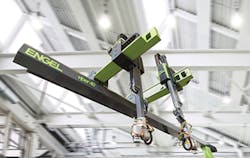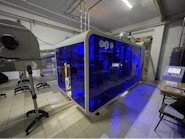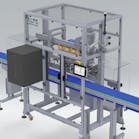Accurate movement and precise positioning of linear robots are critical in higher-end injection molding applications. However, vibrations caused by the movement of the robot itself or by external influences can result in incorrect positioning, leading to rejected parts or longer cycle times.
To address the problem, Engel has launched an active vibration-control feature, which not only compensates for vibrations from the robot itself but also reacts to vibrations from external influences. Compared to other companies' approaches to dealing with vibration, the Engel feature appears to be the first of its kind. Passive vibration control, which Engel added to its viper robot line as a standard feature in 2009, dampens only movements generated by the robot, says Wolfgang Höglinger, manager of development robotics, Engel Austria GmbH, Dietach, Austria. Engel Machinery Inc., York, Pa., represents the company in the U.S.
The new feature, offered since October, is standard for Engel's viper robots, except for the two smallest models in the line. It's not necessary for small robots handling lightweight parts, so it's also not offered with Engel's e-pic pick-and-place robot or the company's easix six-axis unit. On the bigger robots, it functions as a second level of control, complementing the passive vibration control, says Johannes Kilian, manager of simulation and control system engineering at Engel Austria."Simple pick-and-place operations where the part is deposited on a conveyor belt without any requirement of placement accuracy are not so demanding. However, operations which require exact positioning require vibration control," says Höglinger.
Several key steps can be affected by robot vibrations. They include demolding, insert molding and transferring premolded parts from one cavity or mold to another.
Active vibration control uses two industrial 3-D acceleration sensors that take the value of the robot's movement and position every 4 milliseconds. The sensor captures and calculates the movement and position data on its own, relaying a signal for an adjustment to the servo drive through a field bus connection to the program control, says Höglinger.
"Active vibration control can minimize 90 percent of the oscillations after 100 to 150 milliseconds," says Höglinger. Without vibration control, the robot will shake for at least 10 times longer, he says.
The acceleration sensors are enclosed within a box mounted on the unit, and are designed to self-calibrate and recheck their own values. Kilian says that compared to passive vibration control, active vibration control delivers greater positioning accuracy and allows the viper robots to reach a stable working position more quickly.
Before launching active vibration control, Engel offered only passive vibration control. "Passive vibration control is based on a motion signature of the robot," says Höglinger. The robot's programmed path, based on its motion, is calculated without regard to any vibration control. During robot operation, passive vibration control compares the robot's position and motion to the baseline profile, then adjusts to correct for vibration. The recalculated operation of the servo drive is applied cyclically while the robot is moving. That's in contrast to active vibration control, in which adjustments occur in real time.
At Fakuma, Engel demonstrated the new technology using two viper 40 robots mounted on the same beam. One robot held a core and another robot held a sleeve. The robots quickly inserted the core into the sleeve and separated it multiple times without either part touching the other. The vibration control allowed for synchronization of the independent robot movements. During the demonstration, a total of 12 axes were controlled at once.
With active vibration control, Engel now has the possibility of constructing Cartesian robots with even longer beam lengths or higher load capacities in the future. "The beams may bend more, but we can counteract this issue with the active control, allowing us to imagine possibilities in the future that we do not have at the moment," says Kilian.
SOURCES OF VIBRATION
Linear beam robots can shake for a number of reasons. One reason is the movement of the robot along an axis as it starts, stops or changes direction. Without dampening, the entire robotic construction can shake for a long time — seconds — impacting positioning and cycle time. Another cause Höglinger cites is the action of an ejector plate or ejector pins in the mold.
The C-axis also can be a concern, where the swiveling action changes the position of the end-of-arm tooling (EOAT). "When the swiveling position is up, the C-axis can be a certain distance from the vertical axis. When the C-axis swivels down, it is then at another distance. The shift in the center of mass at the end of the arm from the swiveling action has an acceleration and a deceleration motion, which can stimulate the robot" to vibrate, says Kilian.
Depending on its condition, tooling can be another major vibration generator. "If a processor uses older tools where the closing actions are not smooth, each time the tool halves come together is a chance for robot shaking, because beam robots are typically mounted on top of the machine platen," says Höglinger.
Some Cartesian robot manufacturers add weight or design features to dampen vibration; however, the added weight reduces the overall part weight that the robot can handle. Active vibration control's use of the servo drive to minimize vibration allows the EOAT and part to assume a larger portion of the robot's maximum payload.
NEW DRIVE INTRODUCED
Engel also introduced a new multidynamic drive package that is standard for the viper robot that automatically adapts the movement of the robot to the real weight load. The robot operates faster when bearing lighter loads and moves more slowly with heavier loads. The drive package replaces a less dynamic AC servo motor drive.
The drive package incorporates permanent magnetic servo motors with backlash-free transmissions (gears), as well as new programming that identifies the mass of the load, the EOAT type and molded part in the application. The machine operator inputs an operating profile that takes all dynamic values into account, such as torque and acceleration velocity. The drive package allows the robot to smoothly transition between weight and speed limits to achieve optimum acceleration and velocity values, says Höglinger.
The drive system features an efficiency control function that also takes the cycle of the injection molding process into account. Within three molding cycles, the viper achieves the optimal dynamics for the respective injection molding process, for example, reducing its own speed corresponding to a long part cooling stage, without increasing overall part removal time. "The machine operator previously had to calculate the optimal operating speed manually. This optimization is now managed automatically by the viper unit," says Höglinger.
Mikell Knights, senior correspondent
Contact:
Contact: Engel Machinery Inc., 717-764-6818, www.engelglobal.com







